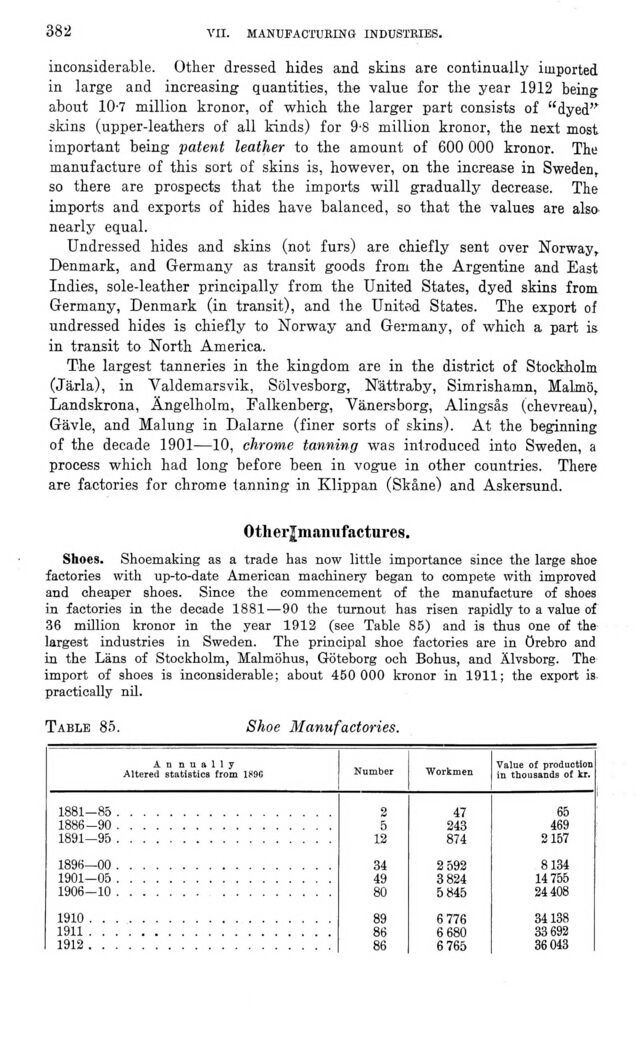
Full resolution (JPEG) - On this page / på denna sida - VII. Manufacturing Industries. Introd. by [G. Sundbärg] K. Åmark - 3. Hides, Skins, and Hair. By J. Landin

<< prev. page << föreg. sida << >> nästa sida >> next page >>
Below is the raw OCR text
from the above scanned image.
Do you see an error? Proofread the page now!
Här nedan syns maskintolkade texten från faksimilbilden ovan.
Ser du något fel? Korrekturläs sidan nu!
This page has never been proofread. / Denna sida har aldrig korrekturlästs.
382
vii. manufacturing industries.
inconsiderable. Other dressed hides and skins are continually imported
in large and increasing quantities, the value for the year 1912 being
about 10-7 million kronor, of which the larger part consists of "dyed""
skins (upper-leathers of all kinds) for 9-8 million kronor, the next most
important being patent leather to the amount of 600 000 kronor. The
manufacture of this sort of skins is, however, on the increase in Sweden,
so there are prospects that the imports will gradually decrease. The
imports and exports of hides have balanced, so that the values are also’
nearly equal.
Undressed hides and skins (not furs) are chiefly sent over Norway,
Denmark, and Germanjr as transit goods from the Argentine and East
Indies, sole-leather principally from the United States, dyed skins from
Germany, Denmark (in transit), and the United States. The export of
undressed hides is chiefly to Norway and Germany, of which a part is
in transit to North America.
The largest tanneries in the kingdom are in the district of Stockholm
(Järla), in Valdemars vik, Sölvesborg, Nättraby, Simrishamn, Malmö,
Landskrona, Ängelholm, Falkenberg, Vänersborg, Alingsås (chevreau),
Gävle, and Malung in Dalarne (finer sorts of skins). At the beginning
of the decade 1901—10, chrome tanning was introduced into Sweden, a
process which had long before been in vogue in other countries. There
are factories for chrome tanning in Klippan (Skåne) and Askersund.
Othergmanufactures.
Shoes. Shoemaking as a trade has now little importance since the large shoe
factories with up-to-date American machinery began to compete with improved
and cheaper shoes. Since the commencement of the manufacture of shoes
in factories in the decade 1881 — 90 the turnout has risen rapidly to a value of
36 million kronor in the year 1912 (see Table 85) and is thus one of the
largest industries in Sweden. The principal shoe factories are in Örebro and
in the Läns of Stockholm, Malmöhus, Göteborg och Bohus, and Älvsborg. The
import of shoes is inconsiderable; about 450 000 kronor in 1911; the export is
practically nil.
Table 85. Shoe Manufactories.
An nuallj Altered statistics from 189G Number "Workmen Value of production in thousands of kr.
1881-85 ................. 2 47 65
1886-90 ................. 5 243 469
1891-95 ................. 12 874 2157
1896—00 ................. 34 2 592 8134
1901—05 ................. 49 3 824 14 755
1906—10 ................ 80 5 845 24 408
1910................... 89 6 776 34138
1911................... 86 6 680 33 692
1912................... 86 6 765 36 043
<< prev. page << föreg. sida << >> nästa sida >> next page >>